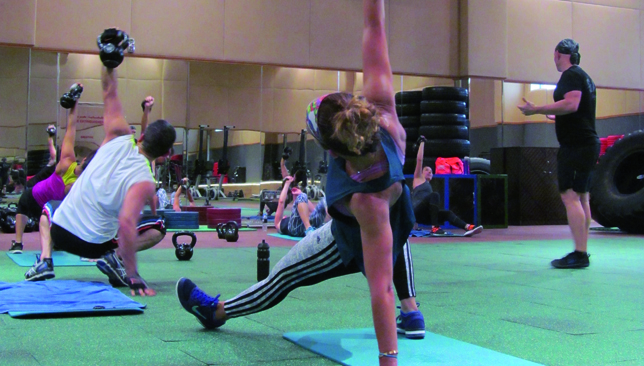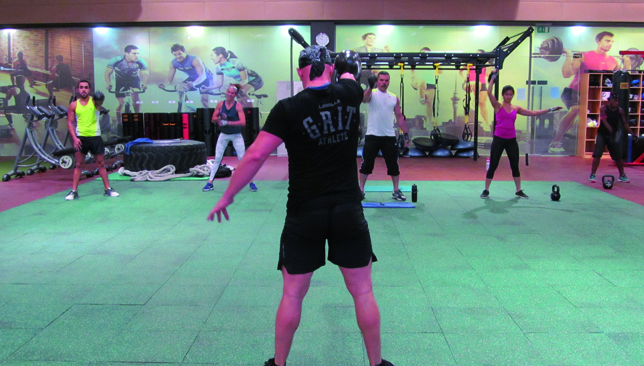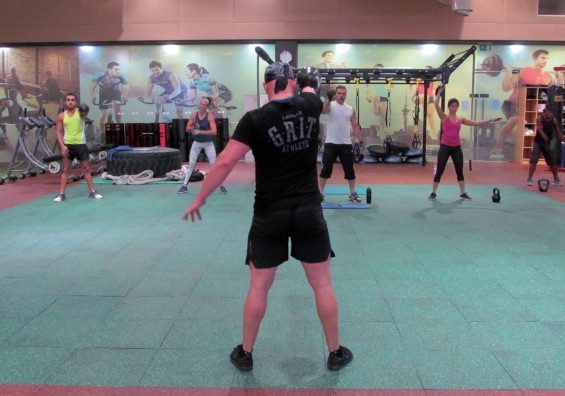
A weight is a weight no matter who’s holding it or what it looks like. And yet the kettlebell remains an untouched mystery to the masses outside of CrossFit.
But that’s slowly changing in Abu Dhabi, thanks to the capital’s ever-experimental Country Club, which has launched a 45-minute masterclass solely focused on this curious cast iron ball.
If you’re keen on your kettlebell swings, deadlifts and halos – or at least have an inkling about what we’re referring to and have been wanting to try them – seek out ADCC’s group fitness trainer Matej Marolt, their king of the kettlebell.
Marolt is the man behind a number of Les Mills classes offered at the club, but has been keen to introduce the cannonball-esque weight on a more comprehensive scale, to prove to members and non-members alike just how versatile and beneficial it can be for a full-body workout.
“Personally, I fell in love with kettlebells many years ago when I started my fitness transformation from a really chubby guy to where I am now,” he says. “I had mostly used them to aid a warm-up routine, and then for a while I had a love-hate relationship with them because they really revealed to me how much weaker I was on one side of my body.
“But for that reason, I ended up sticking with them and loving it, because it’s the simplest tool out there to improve that imperfection. If you do the exercises properly – safely and with good form – there is close to zero chance of injury, too.”
Documented use of the kettlebell goes as far back as the late 1700s in Russia, where, prior to their streamlined design today, they were merely cinderblocks fashioned with makeshift handles.
It was only much, much later that it was introduced to the American world of fitness via former Soviet Special Force trainer Pavel Tsatsouline, who believes the kettlebell to be just as effective as, or even better than, your standard dumbbell.

Matej Marolt leads the ADCC group fitness class.
In a way, they are. Where the two differ is in the fact that the centre of mass in a kettlebell is located away from the hand, making it more ideal than the dumbbell for dynamic swinging exercises; and with that ability comes access to a full range of other multi-jointengaging exercises.
What’s more, because the weight in a kettlebell is not as evenly distributed as a dumbbell, it creates the need for the user to counterbalance and stabilise during their workout (cue core strength and conditioning).
Indeed, you can get both your strength and cardio sessions done and dusted with this bad boy, and the countless kettlebell exercises out there do well not just to help you hone a bulletproof core, but also to improve your balance, power, coordination and flexibility, while blasting fat and toning muscle.
“The variety of exercises out there – and the different focuses they have – is so vast and diverse, people really don’t know,” says Marolt.
A typical class consists of a thorough warm-up, a quick yet in-depth tutorial on kettlebell technique and setup, the main workout routine, and finally a strength and mobility session where usually a popular kettlebell skill will be taught.
Most kettlebell exercises typically start off with a variation of the ‘swing’ – where, with bent knees, you drive the kettlebell up and out in front of you in an arc that begins from just below your groin.

Contrary to popular belief and malpractice, the swing is not powered by the arms, but by the posterior chain (back, shoulders, hamstrings and glutes). Needless to say, a lot of strength is getting developed in a lot of places with near minimal effort.
You’re not even really performing a squat here, but rather just a hinge.
“The swing may be one of the most popular kettlebell exercises but it is also one of the toughest, in relation to calorie expenditure,” says Marolt. “We did single-handed swings today, which was hard enough, but gripping it with both hands and swinging at a higher weight really ups the intensity as well.”
He adds: “Doing just swings for 10-15 minutes…you’ll be burnt out and lying in a puddle of sweat by the end of it.”
We had the “pleasure” of doing close to just that during the main, very short and sweaty, WOD segment entitled ‘The Smoker’. It consisted of a series of ever-increasing repetitions of singlehanded swings, one-handed snatches and overhead presses, as well as goblet squats (holding the kettlebell upside down at your chest while doing wide-legged squats). All performed slowly and with control, no stopwatch-induced panic here.
Yet still, there really was not much left in us after that than to try our hand at the Turkish Get Up during a closing skill session.
One of the most important kettlebell exercises, the mysteriously-named exercise challenges your core and mobility as you, starting supine with the kettlebell raised straight upwards in one hand, carefully stand up and lie back down again.
Somewhere in the process you’re going through the motions of a bridge and a lunge, all while trying your hardest through your core to keep this loose cannon from wobbling overhead as you use the rest of your limbs to get up.
Shoulders, glutes, quads and hamstrings all share the workload too, naturally. It’s not easy to do, and it shows in our painfully jerky attempts. There is clearly a lot you can learn about all-round mobility in this class, too.
The Turkish Get Up is one perfect example, as is that halo we referred to earlier (it’s where you hold the kettlebell in both hands and circle it round your head).
“That’s a really excellent exercise for overall shoulder mobility,” Marolt says about the halo.
Finally, he urged newbies not to be intimidated by this ball of iron anymore; it’s the must-experience gym accessory of our time.
“My class caters for all fitness levels, but it does honestly tend to attract our fitter clients. That being said, we have a wide range of weights offered, and even if the lightest kettlebell is too heavy for you, we can adapt the workout to be done with even lighter weight plates.”
And even if a full-on 45 minutes doesn’t sound like your thing, the kettlebell is certainly worth introducing into your home gym or personal practice.
We’re sold, and not just on the fact that such a diverse training tool can fit under the bed or in a gym bag, halving the amount of equipment we need cluttering our space.
“I’d suggest to start you purchase one light (around 8-12kg) and one heavy (16-20kg),” advises Marolt. “Even better if you get a pair of each because you can then do both single and double-grip kettlebell exercises that way, the latter offering a whole different aspect to your training and your development.”